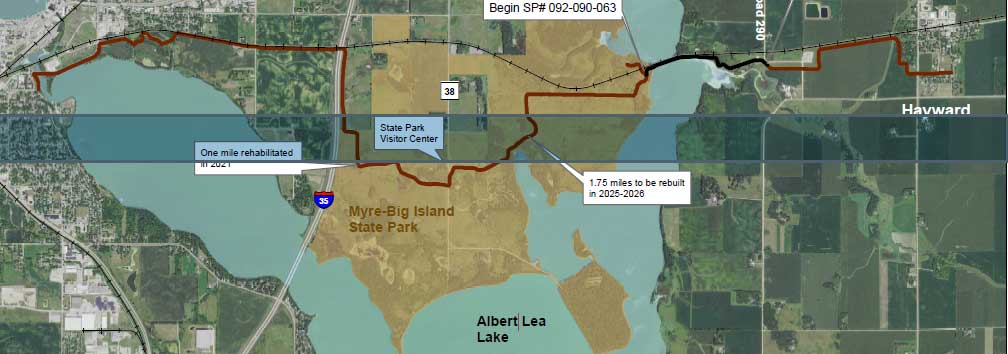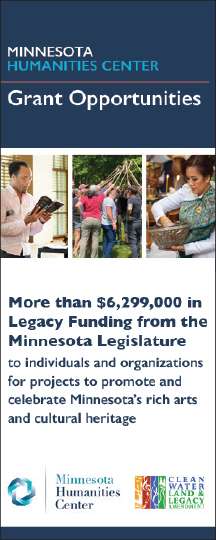Nature Steps In: A State Trail And A Nest
By Deborah Locke, Information Officer, Minnesota Department of Natural Resources
Sometimes eagles call the shots on the Blazing Star State Trail in south central Minnesota.
In February, tree cutting was slated to begin as part of trail construction which included a 100-foot trail bridge across Albert Lea Lake from Myre-Big Island State Park to Hayward, MN. The entire construction project, consisting of an expanded trail, a bridge and fishing access, is expected to be finished in late 2025 or early 2026.
Before we get into the part about why the construction halted, consider this. Usually, I write about Minnesota state parks and reasons for visiting them. We are blessed with lots of parks and state recreation areas. In addition, Minnesota has 1,300 miles of state trails. That is right, whether they’re your standard ten-foot wide paved trail, or a railroad-grade bike trail, or a natural terrain horseback riding trail, or a mountain bike trail: all exist for your use and enjoyment. For a list of Minnesota state trails, go to mndnr.gov/trails.
One choice of trail is the Blazing Star, that is currently comprised of two separate segments, a five-mile trail connecting Albert Lea Lake in Albert Lea to Myre-Big Island State Park, and a second 1.5 mile trail that extends from the community of Hayward east toward the state park. When the current trail segment including the 100-foot bridge are completed, a single, continuous trail will extend between Albert Lea and Hayward, passing over Albert Lea Lake and through Myre Big Island State Park.
When completed, the Blazing Star will grow to 20 miles in length, from Albert Lea to Austin, MN. Construction on the new trail segment should have started in February.
Then mother nature stepped in with an alternative timeframe. Parks and Trails staff spotted a new eagle nest in a tree within 50 feet of the project clearing limits. After years of planning between municipalities, a railroad company, power company and state agencies, after years of hard work on legislative funding and approvals, years of land acquisition, and environmental and archeological testing – after all of that – two nesting eagles lowered the boom.
“It’s not unusual for construction to start and then to have an issue arise,” said Joel Wagar, PAT Area Supervisor. “But this is a bit unusual.” Since bald eagles and occupied nests are federally protected, PAT staff worked with the U.S. Fish & Wildlife Service to obtain necessary permits so that clearing work could proceed with some level of mitigation for project-related impacts.
Like most trail projects, the Blazing Star State Trail evolution moved forward in fits and starts, Joel said, starting in 2003. Land acquisition is a big challenge; sometimes owners decide not to sell. The railroad and powerline presence added complexities to the project. The first segment connecting to the park was finished in 2003; the second segment, from Hayward to the lake, was finished in 2016.
More immediately, near Albert Lea Lake, contractors needed to build a temporary worksite access. Its full completion has been delayed until July, well past eagle nesting season. Some trees were cleared but only until March 8 to minimize disturbance to the nesting eagles. Staff members at Myre-Big Island State Park have monitored the nest for any sign of eaglets; so far, they have not been seen. Eagles usually start to fly when they are very young and leave the nest permanently the summer following birth. The adult birds, in addition to their young, have protection under federal law.
After the trees are cleared, work starts on the trail grade and bridge abutments. After allowing the newly constructed grade to settle over the winter, paving begins in 2025.
The $4 million segment funded mostly through the state Department of Transportation is eagerly anticipated by Albert Lea and Hayward residents. At a February community meeting in Albert Lea, the resident’s frustration over the wait period was replaced with excitement for the new trail connecting the two communities and the park.
They’ll need a little more patience. One or two eaglets and their parents received the right of way.
(Map key: the black line shows the proposed bridge location, red line shows the current trail
Images courtesy Minnesota DNR.












